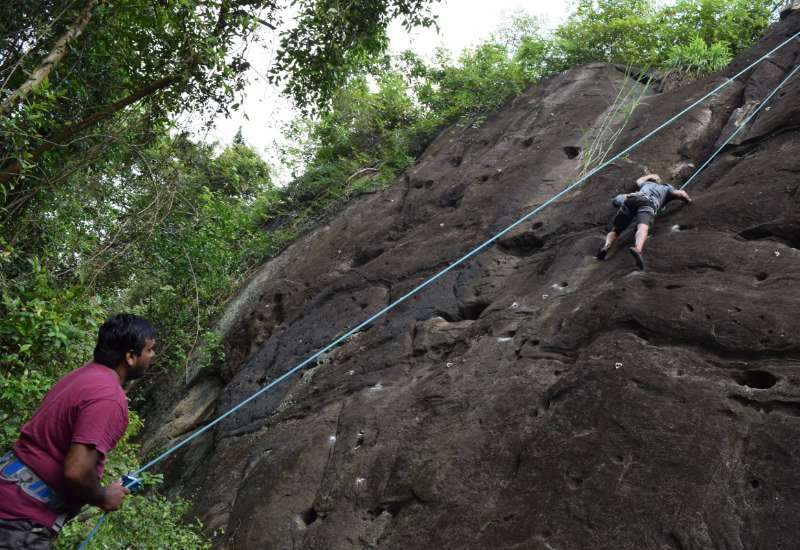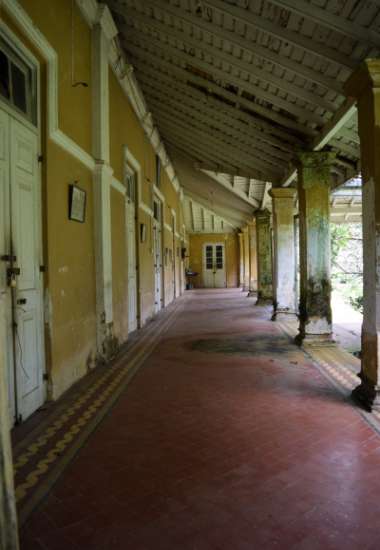
Rock climbing in Kodigahakanda Sanctuary with Climblanka
Sri LankaMost of my childhood was spent on trees, crawling up and down walls and on rooftops. I bet quite a few of you can relate. So when Naz randomly asked me one day if I wanted to go climb a rock over the weekend and I at once said yes! I had no idea what I was getting into but the mere thought of climbing anything excites me still to this date – probably one of the things that never changed about me, never will, no matter how old I will get.
The location and the team
The rock climbing location that we went to is managed by ClimbLanka and is located near Kahathuduwa within the Kodigaha Kanda protected sanctuary. You need to travel around 2.5km towards Horana on the 120 route and turn left from Olaboduwa Kanda Road. Continue down the road for about 1.5km and at the start point the guide will come to meet you.
On the way we mistakenly drove into a quarry which is located onto the right of the road leading to the climb location. Just keep straight and you should be able to find your way. The road to the location is a bit uneven, I must warn you. Drive slowly when going through the potholes and bumps.
Once at the meeting point, our instructor for the day Sachith led us through the small jungle to the rock face. They take bookings for slots for a minimum of 2 people and costs Rs.2700 per person. We booked the Saturday morning slot from 8.30 am to 11.30 am.
History of Kodigaha Kanda Sanctuary
The surrounding area actually used to be one large estate initially owned by businessman and philanthropist Sir Charles Henry De Soyza which had been broken up due to the implementation of the Land Reform Act of the 1970’s.
Since then most of the natural rocks in this area have been blasted largely by illegal quarrying and by 1994 most of the surrounding area deforested, resulting in the streams and wells running dry.
Realizing the value of the forests and the hillock in the storage of ground water, the local villages formed on their own a Society called the ‘Mihithala Mithuro’ (earth-friends) in order to protect the remaining forest area. So keep in mind to not throw any waste in the jungle or the area around the rock face. Leave only your footsteps behind – nothing more.
The “Rock”
At the point of writing this article, the surface that we climbed is the only one that is available for recreational climbing in the whole of Sri Lanka, Sachith said. Therefore it is apt to say that this was truly a one-of-a-kind experience; one I highly recommend you try out yourself.
Sachith is a self-taught climber but he said that he had acquired a wealth of knowledge and experience on the subject over the years from working with international climbers.
The surface has been drilled with several anchor points to assist with the first climb up to the top of the rock face where the rope is drawn onto the top anchor. He assured us that this anchor was secure. Well I did trust him and we came back alive.
Orientation
Sachith first ran us through the basics of rock climbing. As complete novices to the sport this is very useful information. He spoke of the different techniques of climbing including smearing and edging, how you should plan your climb, how you should manage your rope, what should not be done during a climb, the role of the belayer who will be holding onto the rope that you’ll be harnessed into, and also some of the common mental and physical challenges that come with rock climbing.
At this point we were thinking it wasn’t that hard. We’ve done our fair share of hiking and were confident that we’d be able to manage without much difficulty. We couldn’t have been more wrong actually – the climb was no cake-walk. We really overestimated ourselves.
The equipment
Rock climbing requires specific equipment and almost all of them enhance your safety.
First of all, there’s the special climbing rope, the harness and the helmet that one must be geared up with for safety. Then you have the special climbing shoes which allow you to grip the surface of the rock securely. There’s also a belay device and worn by the belayer that helps him control the rope that you’ll be linked to. All these equipment must be of good quality to ensure that you’re secure during your climb. They have several sizes of shoes, harnesses and helmets to fit most people.
The carabiner that they use is able to hold a load of 24 kN, or 2400KGand the rope can carry substantial load as well, so were pretty confident that we’d be safe while hanging onto our dear lives. Sachith gave us a full rundown on how to use and wear the equipment. He also mentioned a few phrases and terms that are specific to rock climbing used to communicate between the climber and the belayer.

As novices this is just a formality as you end up using the usual, phrases, such as okay, let’s go, stop, hold, I’m going up, I’m coming down, or if you speak Sinhalese, buduammo athaarinna epa, mata baha, maawa pallehaata ganna, mama mareei etc.
The climb
I was the first to take up the challenge of climbing the rock. I got all harnessed up and put on the shoes (which are intentionally extremely tight so that you have a very strong toe area). Sachith taught me the technique of threading the rope around my harness, which is called a double thread 8 knot. Once this was done and he gave me the go ahead, it was time for me to get started.


The initial few meters of the climb were relatively easy. Sachith gave instructions on which crevices and ledges we should hold onto or keep our feet on.
There were a few tricky places where you need to place both your feet and hands in order to pull or push yourself forward. One of the main things he said was that when you’re new to climbing you only think of the next immediate step. This can lead to you getting stuck as you progress up the rock as you may run out of footholds. Experienced climbers think a few more steps ahead so they are able to progress swiftly. Practice makes perfect.

After about 5 meters up the rock I came to a point where I couldn’t figure out the next step. I struggled for a few minutes trying to identify where I should move onto. It was then that Sachith asked me to look and feel for a couple of foot and hand-holds and use them to move across the surface. This is when I slipped and went sliding across the rock face – since I was secured onto the rope, there was nothing to be worried about.
The whole experience of falling a few feet was quite exhilarating. After regaining my balance, I went back to where I was before and slowly started to find the correct climbing path again. This time I was successful and was able to go right to the top. I had to use pretty much all of my strength to pull myself up, from the upper body and the lower body. It was tiring and mentally challenging as well but I felt a sense of accomplishment and relief when I reached the top.

Then came the descent where you lean against the rope while the belayer slowly slacks off the rope, thus letting you down. Although I had only taken 10 mins to climb up and 2 mins to come down it felt a lot longer.
One by one the rest of the group too did their climbs. 2 of them reached the top. One chickened out halfway screaming expletives. I climbed one more time, but the second time was hard on the body as my fingers were sore from the first climb. I had bruises and scratches all over as well.



Check out Nazeer’s video of the climbing session on his YouTube channel, The Traveling Boots
Uda Bangalawa a.k.a Olaboduwa Bungalow
After we were satisfied that we wouldn’t be able to climb anymore, we decided to visit the Uda Bangalawa nearby. It was built by Sir Charles Henry De Soyza in the late 1800s and during its heyday had seen many famous visitors including Sir Baron Jayatillake, Sir John Kotalawela, Mr. D. S. Senanayake, Thomas Moore and Robert Horton among the English elite and foreign visitors such as the Indian Poet, Rabindranath Tagore and Crown Prince Akihito of Japan. The Asoka tree planted by the Crown Prince in 1958 is still to be seen in the garden.

Currently the structure is dilapidated but with a little work, this can be converted into a holiday home/boutique hotel that not only locals but international tourists will also find appealing considering that it is located smack in the middle of a forest allowing guests be at one with the nature.


All in all, it was a very good outing and we thoroughly enjoyed the experience and I fully recommend it for all you adventure seekers.
For more information and bookings,
Web: http://www.climblanka.com/
Facebook: https://www.facebook.com/climblanka/
Email: info@climblanka.com
Phone: (+94) 774 721 937
Find Climblanka on Google Maps:
Leave a Reply